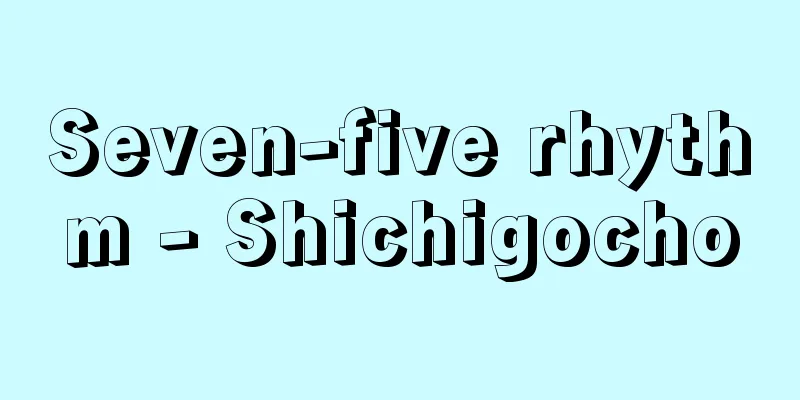Seven-five rhythm - Shichigocho

|
It is the name of the rhythm (tune) of Japanese classical poetry and verse, and, along with the 5-7 rhythm, it is the basis of it. Generally, classical Japanese verse has 5-beat phrases and 7-beat phrases as basic units, and combinations that follow the pattern of "7-5/7-5/7-5/..." are called 7-5 rhythm. An example would be a tune like "Iroha ni ho he to chirinuru wo/waka yo tare so tsune naramu/...", and in tanka, it would be a tune like "Amatsu kaze/kumo no kayomi michi fuki tojiyo/otome no kata shibashi todomemu" (The Hyakunin Isshu, by Sojo Hensho). From the end of the Nara period, it overwhelmed the 5-7 rhythm, and throughout the Heian period, the Middle Ages, and the early modern period, the 7-5 rhythm was used extremely widely, not only in waka poetry, but also in various folk songs, military chronicles such as "The Tale of the Heike" and "The Tale of the Taiheiki," as well as in Noh plays, Joruri lyrics, and Kabuki dialogue. Compared to the solemn and grave tone of the 5-7 rhythm, the 7-5 rhythm has a light and elegant tone, which is thought to have matched the needs of the times from the Heian period onwards. Even in modern times, the 7-5 rhythm was the mainstream for new style poetry, and it was also widely used in school songs, such as "With a whistle, my train leaves Shinbashi quickly..." (Railway Songs). [Yukitsuna Sasaki] [Reference] |Source: Shogakukan Encyclopedia Nipponica About Encyclopedia Nipponica Information | Legend |
|
日本の古典詩歌および韻文の韻律(調子)の名称で、五七調とともに、その基本をなすもの。一般的に日本古典韻文は5拍の句と7拍の句を基本単位にしており、その組合せにおいて「七五/七五/七五/……」の続き方をするものを七五調とよぶ。「いろはにほへと ちりぬるを/わかよたれそ つねならむ/……」といった調子がそれで、短歌では「天(あま)つ風/雲のかよひ路 吹きとぢよ/をとめの姿 しばしとどめむ」(『百人一首』、僧正遍昭(へんじょう))のように「五(/)七五/七七」の調子をいう。奈良朝末から五七調を圧倒し、平安朝・中世・近世を通して、和歌はもとより、各種の歌謡、『平家物語』『太平記』などの軍記、さらには謡曲、浄瑠璃(じょうるり)の詞章、歌舞伎(かぶき)の台詞(せりふ)など、きわめて広く七五調が用いられた。五七調が重厚荘重な調子であるのに比べて、七五調は軽快優美な調子で、平安朝以降の時代的欲求に合致したためだろうとされる。 近代に入っても、新体詩は七五調を主流としたし、唱歌の類にも七五調が大いに用いられた。「汽笛一声 新橋を/はやわが汽車は 離れたり/……」(『鉄道唱歌』)などその数は多い。 [佐佐木幸綱] [参照項目] |出典 小学館 日本大百科全書(ニッポニカ)日本大百科全書(ニッポニカ)について 情報 | 凡例 |
<<: Seven-word poem - Shichigonshi
Recommend
Holothuroidea
…A general term for echinoderms belonging to the ...
Zenkoji Temple
[1] A temple located in Nagano Motozencho, Nagano ...
Gastroenterology
…The branch of medicine that treats and studies d...
Oobuka - Oobuka
...It was named after the Sando-gasa, used by cou...
Database Management System - Database Management System
Software for building and managing databases. Also...
Camping
…See the entry on the neck. A headache is a sympt...
Oura [town] - Oura
A former town in Kawanabe County, southwest of the...
ACP - ACP
African, Caribbean and Pacific Group of States : C...
pepino
… On the other hand, karst in tropical and subtro...
value of service theory
...In addition, with regard to public transportat...
tumbling
...An exercise method aimed at developing a healt...
Anshan (English spelling)
The name of Elam. Elam was the name of an ancient ...
Janneau, G.
...Then, in the second half of the 19th century, ...
Greenbrier
...One species of the South American Smilax genus...
Dinār (English spelling)
A gold coin that circulated in Islamic society alo...

![Usubetsu [Hot Spring] - Usubetsu](/upload/images/67cf88185b082.webp)







